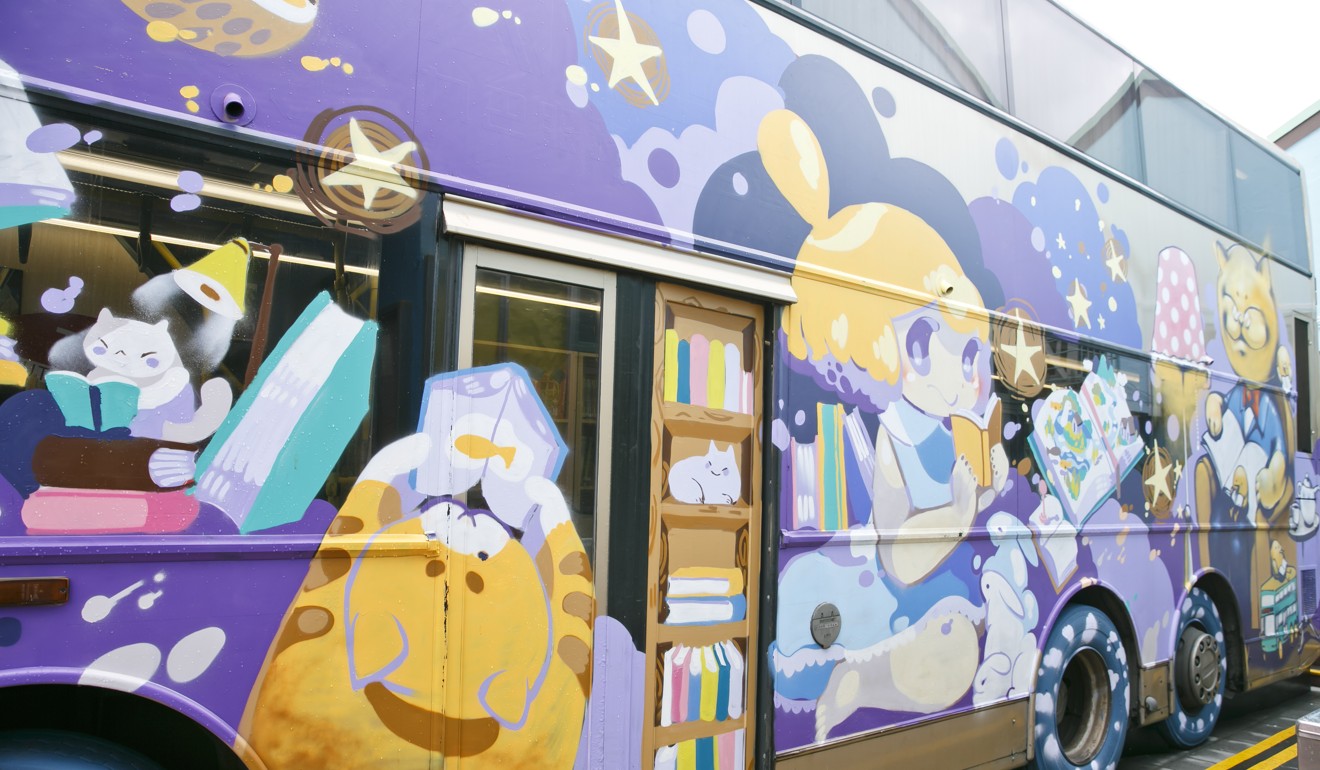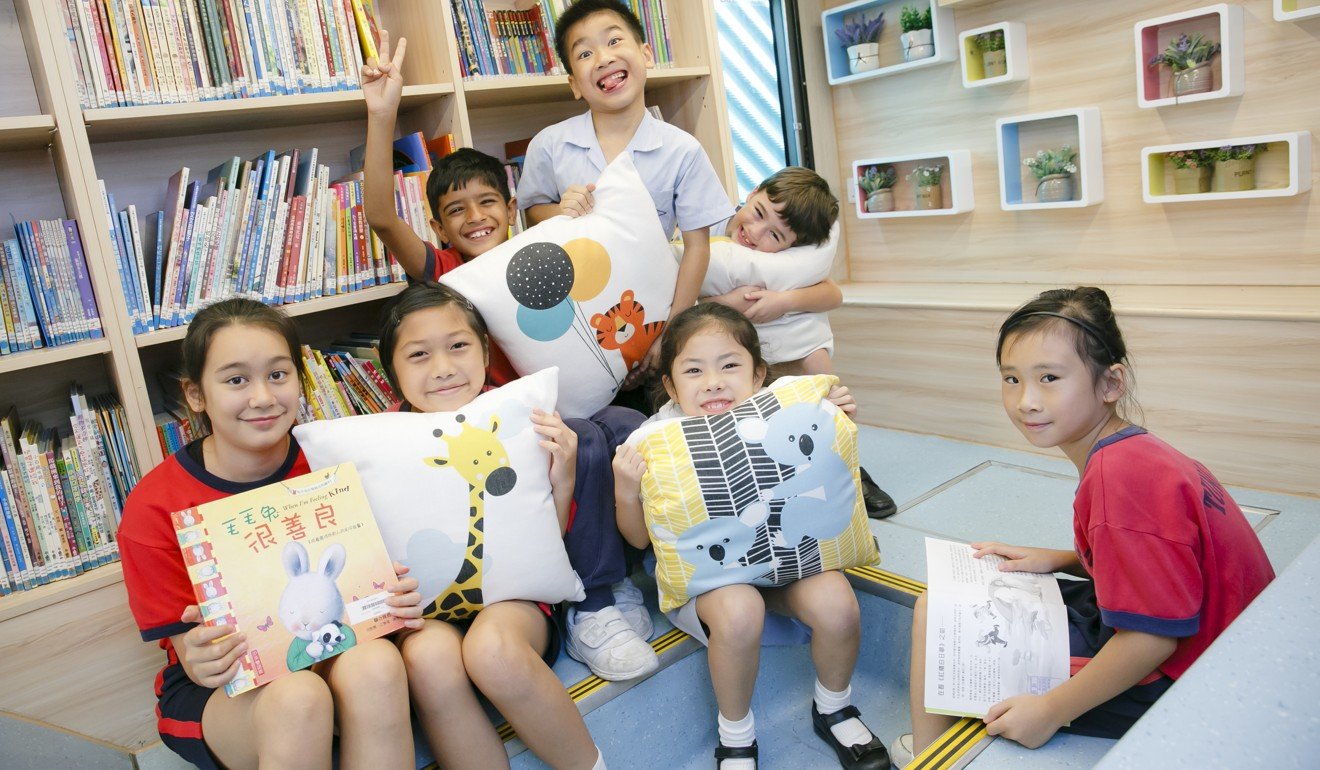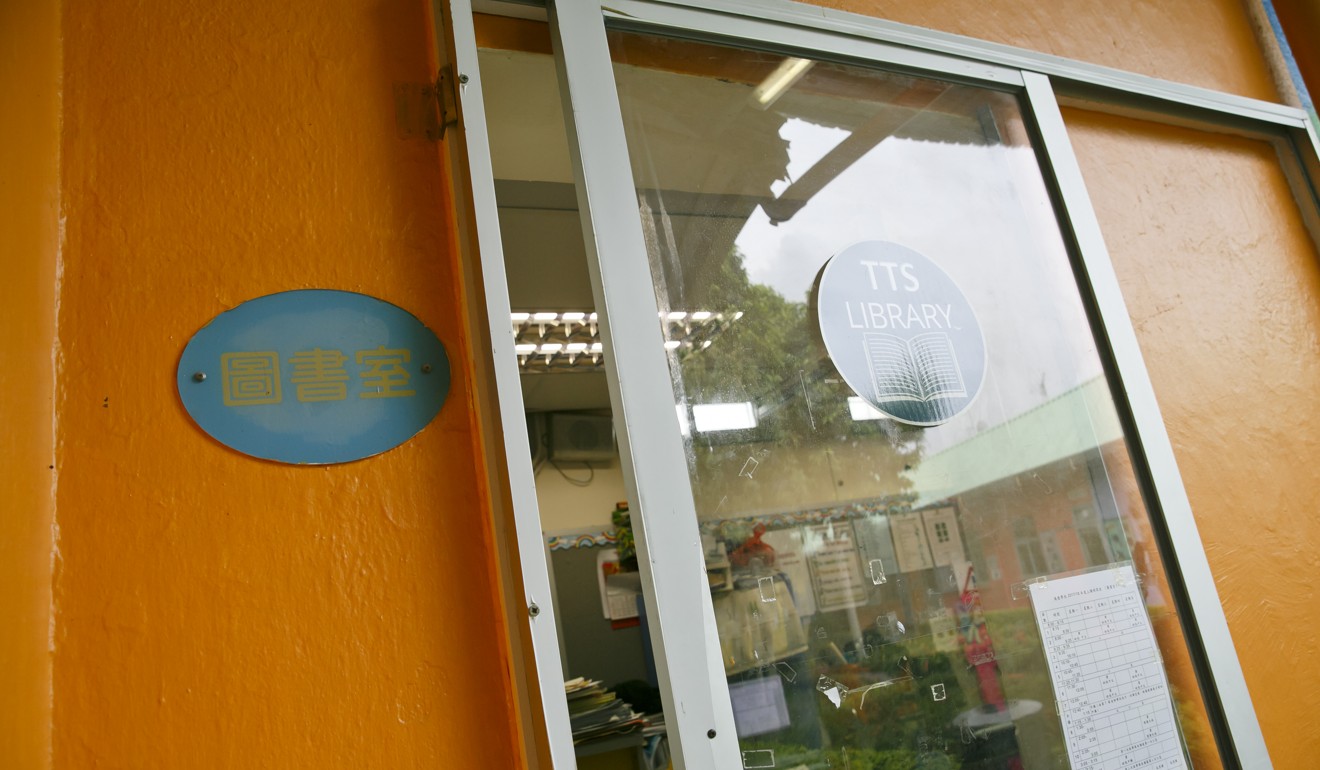
Ticket to read: how Hong Kong village school has turned double decker bus into library
Retired city bus turns up – as part of scheme to donate old vehicles to worthy causes – just when primary schoolchildren ask teachers for bigger premises
Tucked away in the depths of a village on the eastern tip of Yuen Long in Hong Kong’s New Territories, a double decker bus stands as a permanent fixture in the playground of Tung Tak School.
It has been the new library at the primary school in Kam Tin since the end of June.
With the outside walls covered in whimsical illustrations, the former Kowloon Motor Bus (KMB) vehicle evokes almost no memory of its former role of serving the 64K bus route between Yuen Long West and Tai Po Market station.
When the children said that they wanted a bigger library, I sought out different ways to expand it
Seats were taken out of the vehicle and in their place sprouted shelves of books.
Colourful beanbags are strewn across the upper deck and a television covers the rear window.
The school has even given its acronym “KMB” another meaning – “Kids Miraculous Bus”.
The bus-turned library has been given the number 1957, which echoes the year the school was established.
“When the children said that they wanted a bigger library, I sought out different ways to expand it,” school principal Wong Wai-lap said.

The school’s old library, with walls lined by shelves full of precariously balanced books and stationery, could accommodate only about seven people.
“We thought of stacking up shipping containers, but that would have involved rather complicated procedures,” he said.
With only one class in each grade, the school houses 180 pupils, with 20 per cent of them non-Chinese-speaking children who come from Canada, Nepal and Pakistan and the United Kingdom.
Children from indigenous Kam Tin families make up the bulk of the class mix, with a handful of new immigrants, as well as youngsters with special education needs (SEN) and mild dyslexia.

Wong said the school’s population has ballooned in recent years since it introduced the “happy school” concept, which has attracted more villagers as well as an intake of pupils from Yuen Long and Tin Shui Wai.
Children are naturally drawn to buses, which makes it such a stimulating process
There are now 18 full-time teaching staff there, including 12 entitled teachers.
Last year, some classes were held outdoors “underneath a tin roof in the hot, rainy or cold weather”, said English teacher Miranda Breding, who started working at the school in 2010.
“For my lessons, we have to haul [tables] in and out of the rooms to accommodate [all] the children.
“We had to get creative with coming up with space.”
The school does not have a hall for assemblies either.
Wong pointed at the canopy tents mounted on the playground as he said: “These were just borrowed for the launch of the bus library. If it rains, there are a lot of activities we cannot do.”
This means the school has been left to its own devices to invent new ways to maximise all of the available space.

Measures have included vacating classrooms for music lessons and after-school activities such as table tennis and dancing classes.
Desks in the computer room are also specially laid out so that the space can double up as a regular classroom.
The school applied for more building land seven years ago and got the green light the next year.
However, bureaucratic problems, such as clearing land rights and waiting for the Housing Authority to process the application has slowed down the process, Wong said.
Construction is expected to finally begin next year and finish by 2020 – nearly 10 years after the school first lodged its planning application.

Then – like a miracle – the KMB rolled out its “Used and Retired Bus Programme” near the end of 2016. The programme has led to the donation of retired single-deck and double-decker buses to non-profit organisations.
According to the law a franchised bus must be retired from service before it is 18 years old. During the period 2014 to 2017 more than 2,650 franchised buses have been replaced.
The Transport and Housing Bureau has predicted that, in the five years up to 2022, the KMB will retire 1,225 buses in its fleet.
Before the donation scheme, the old buses would have been dismantled and the parts sold or recycled. Applicants have to submit a proposal explaining how the old vehicles will be upcycled.
The first KMB bus in the ‘Used and Retired Bus Programme’ was donated to Buddhist Lim Kim Tian Memorial Primary School last August
“We look at the sustainability, educational purpose and feasibility of [each] school’s proposal,” Emily Hui Wan-han, KMB’s head of communications and public affairs department said.
“We also weigh their relevance to the bus.”
She added that the background of students is not one of the considerations.
“Children are naturally drawn to buses, which makes it such a stimulating process,” she said.
“What I admired about Tung Tak’s proposal is its intention to open the library bus to the Kam Tin community.”
The first KMB bus was donated to Buddhist Lim Kim Tian Memorial Primary School last August. It was revamped into a STEM classroom and a reading room.
Tung Tak was the fourth beneficiary of the scheme. The latest – eighth – donation took place on July 24.

When Tung Tak got the go-ahead in 2017, it soon faced its first major obstacle – getting the 10.6-metre (35-foot) long double decker bus through the narrow, one-way driveway that leads up to the campus.
Discussions took place with nearby residents to use part of their land to expand the lane and the school gates were also rebuilt to make way for the vehicle.

“It took us half a year to sort everything out,” Wong said.
When the bus finally made its way into the school grounds in January, pupils kicked around ideas about how to deck out the bus.
Cats are chosen as a common motif [in the mural on the library bus] ... because we want our students to be curious like the animal
“Our pupils mostly come from low income families and, despite being a subsidised school, there are quite a few limitations,” Wong said.
“It is quite difficult to source hundreds of thousands of dollars for renovation fees from the government.”
In the end, Hong Kong-based illustrator Bao Ho Man-wai offered to decorate the bus for free, while one of Wong’s friends volunteered to carry out the interior renovations for one third of the tender price. Pupils took part in the painting process, too.

Wong said there is a meaning behind the illustrations.
The mural features a bespectacled cat flipping the pages of a book beside a reading lamp, an orange tabby reading about fishbowls and a little girl reading aloud to a bunch of rabbits.
“Cats are chosen as a common motif because we want our students to be curious like the animal,” he said.
[I chose the nickname ‘Dandelion Principal’ because] as a Christian, I believe in spreading love the way a dandelion propagates seeds
Wong, who is not from Kam Tin, started teaching at Tung Tak in 2006 and the baton of being the school’s head was passed on to him in the 2017-18 school year.
“It’s been almost 12 years now – time flies,” said the accounting graduate.
It was not until his second year at the school that he studied for his education diploma.
Inspired by some children from Gaia School in Tuen Mun – a school that promotes nature education, where pupils and teachers acquire nicknames from the environment, such as “stone” and “dragonfly” – Wong chose to give himself the moniker of the “Dandelion Principal”.

“We devise different strategies to help our pupils – for instance pull-out programmes and adjustments of homework.”
Classrooms are inclusive, meaning that SEN students take the same classes alongside their classmates.
To cater to non-Chinese speaking pupils, children are grouped according to ability for Chinese classes. “All Chinese lessons [across all grades] are arranged in the same time slot,” Wong said.
“That means if a primary five pupil has the Chinese proficiency of a primary three [pupil], he will learn with other primary three classmates.”

